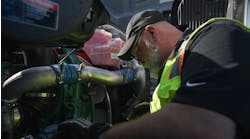What would you think if I told you that I had a parts supply business and that, for a small monthly fee over and above the cost of the part, I would guarantee the supply of any critical part you need, plus would deliver the part to your door within two hours of you placing the order?
What's the catch, you ask? The catch is that you would have to sign up and pay for the part in advance. No, you can't wait for the breakdown.
Would that be a viable business? Do you think I could get companies to sign up for the service?
Upfront Decisions
To take advantage of this program, you would have to make some decisions, including which parts you would sign up for. Think about it. Not all your parts should be covered by this program.
For example, if you are a fleet operator, you would never put common filters, batteries, tires or brake parts under the program. In fact, anything available same-day from your heavy duty parts houses could be skipped.
If you had a business where all your parts could be obtained from distributors the day of order or overnight, you might not need my service.
But let's say you had some old fire trucks which had to be available for safety reasons, or you operate mobile drilling rigs or specialized trailers. Those units will have parts that you will have trouble getting.
You wouldn't need my service for equipment that is not critical, or where you have enough backup capacity to continue running your business until the replacement part comes in and the unit can be brought back into service.
Parts Selection
Which parts would make sense for my service? Those parts that meet at least some of the following criteria:
- Long lead time to get
- Are expensive
- Have been hard to get for some other reason
- Are obsolete and unavailable from the OEM vendor
- Are for equipment that is critical to your operation
- Are needed to make the public, employees or environment safe
My service would be a perfect fit for these parts and my customers would be pretty "sticky," staying with me for a long time as long as they have the asset and as long as the lost opportunity from downtime exceeds the cost of my program to them.
Sunk Costs
What happens after three or four years when a customer has not used the part? Should you remove it from the program?
This is the critical question. The customer has paid for the part, along with a few years of premiums. What math would you use to determine whether to keep the part in the program?
First, and I know this is painful, ignore the sunk costs - unrecoverable past expenditures. Whatever you paid in is spent and gone. The only thing that is important is to compare the fee for the program to the loss from having the asset out of service.
If you want to take it further, look at the probability of breakdown times versus the cost of the breakdown and compare that to the fee charged to have the part in the program and available. As long as the fee is the lower of the costs, the part should stay in the program.
It would be wasteful to pay for even one year unnecessarily. To avoid that situation, you want to be looking at the parts in the program every year to make sure you are not paying for a single part you don't need.
In Place Now
I'm not actually planning to start up a company to provide a guaranteed critical parts service. So, why would I discuss it?
Because many of you are already running this service for parts in your stockroom. Right now you have parts on the shelf that you paid for and every year they soak up a little fee for storage and warehousing costs. These parts fit the aforementioned criteria.
Since this is somewhat like insurance, I call these parts insurance policy spares. The risk you are insuring is against downtime. The insurance premium is the fee to hold to the part.
I recommend that you dispose of the stored part when the cost of holding it exceeds the costs you are trying to avoid, figuring the probability that the unit that uses the part will fail in the next 12 months.
That would be the only reason to retire the part before you retire the last unit that the part is used on. If you do retire the part early, you leave yourself uncovered.
That is a business risk that is fine if it is known and agreed to by both the equipment maintainers and the operations groups. For example, can the operations group wait three months to get the unit back in service, and can the maintainers live with the risk of the downtime?
If it turns out that you need the part after all, don't whine about it. Celebrate that you successfully made a difficult decision and move on. You will win some and lose some. This is the mindset you need when managing parts inventories.




